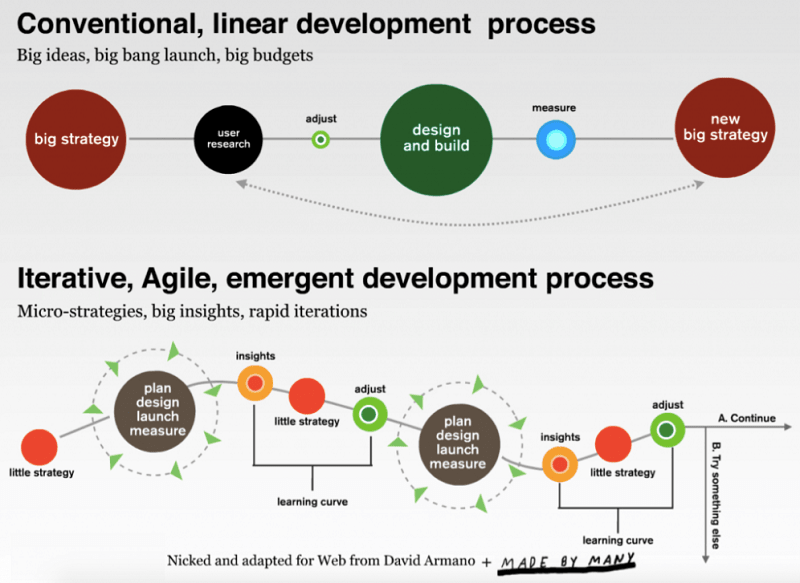The marketing world is abuzz with talk of “agile marketing,” a term borrowed from the software development world that represents the desire to do more with less – and faster, but without sacrificing quality or efficacy. Here’s what you need to know about agile marketing.
Definition of Agile Marketing
Agile marketing is a process of finding, testing and implementing a series of focused projects related to the marketing of an organization. The term “Agile” is commonly used in the world of software development and design. A team of developers set development objectives over a certain amount of time (usually a week). Then, each member of the team focuses on those very few elements. Once either the time set has expired or the project is completed, a review is done to gauge certain metrics.
Agile marketing uses the same process in the field of content and advertising. Certain marketing projects (i.e. ad campaign, landing page testing, etc.) are subdivided into tasks in a planning phase. Next, the tasks are carried out. Finally, the team reviews and improves their tasks based on lessons learned in the previous stage (often called “sprints”).
How Agile Marketing Works
Conventionally speaking, marketing has been about large campaigns and one big push at a time. Things like McDonald’s “I’m lovin’ it” are multi-million dollar marketing strategies to ingrain slogans and offers into the minds of the public. Shows like Mad Men and movies such as What Women Want convey that marketing is about having a catchy idea that just works. Agile marketing is significantly different. Those differences help us to understand how Agile works and can be seen in two broad ways.
Size of Marketing Campaign (or Strategy)
McDonald’s has spent a fortune to get their jingles to spread to more than 100 countries (and 20 languages). It’s also paid off for them. However, it may not have. There are countless examples of large marketing campaigns failing. One of agile marketings best advantages is the ability to fail without large budgets wasted.
Instead of a multi-national endeavor, agile marketing campaigns are smaller strategies attached to a few large key metrics. For instance, if a small retail bank would like to see more deposit accounts, the focus of all marketing would be to fuel getting that result. Instead of a big push around a slogan or concept, every piece is to accomplish something particular.
Type of Details Involved
You can imagine the details that go into a big campaign.
- New sandwich containers need to say “I’m Lovin’ It”
- Directors and actors for commercials
- Finding a star to sing the jingle
- Prepping the team (not involved in marketing)
These are only a few details handled by teams of people over the course of years both before and during the campaign.
Many details are also involved with an agile marketing campaign. Although, these items are to help implement and gauge the results of smaller campaigns. Some of these things could include:
- Creating 2-3 variations of copywriting for a Google Adwords campaign
- Testing the color of a button on a landing page
- Experimenting with different demographics or buyer behavior in Facebook Ads
Instead of an explosion of marketing materials, agile is more like a controlled snowball rolling down a mountain—getting bigger and picking up speed once it finds the right path.

Screenshot via MarketingStream.io
Benefits of Agile Marketing
Agile marketing offers multiple benefits to companies; many of which may not be considered.
- Clear Focus: Instead of a marketing company (or in-house team) coming up with a way to spin your product, the goals will be clear. You want X to happen, now let’s come up with a list of marketing strategies to test over time and see which ones work best.
- Nuanced Campaigns: Demographics and broad marketing isn’t effective, especially for small to medium sized businesses. Buyer behavior and understanding the intuitive decisions of your target buyers is vital to marketing success. Agile allows for these to influence their materials and tests to maximize conversions, making smaller marketing audiences profitable.
- Consistent Growth: Using data-backed strategies and increasing the effort of what works creates predictable results. Revenue, traffic and other metrics can be forecast accurately as opposed to the risk of a broad marketing campaign.
Implementing Agile Marketing: 3 Questions to Ask
To begin implementing agile marketing in your organization, you should first answer three important questions.
What Drives Business?
Here, you’ll need to find the few metrics that really drive your business forward. For a bank, it may be deposit accounts. Ecommerce could need high social and organic traffic. A SaaS app may need more subscribers to the free version of the software. Find 1-3 metrics (the fewer the better), but ensure that it truly drives business.
What Can Improve That Number?
The marketing team should come up with experiments to test accomplishing this goal. For instance, if an ecommerce store has good traffic, but poor conversions, the experiments could test landing pages. One week, test two different descriptions. Next week, test the call-to-action. Keep going and increase what works. If you find that mentioning certain words works on 10 products, increase it to all your products.
How Will We Organize Our Efforts?
Agile marketing uses terms like “experiments, iterations, sprints” to define how the team works. Your experiments, iteration times, and sprint lengths will differ. However, coming up with a set schedule to begin will alleviate confusion and can (and should) be adjusted over time.
Agile marketing can work for any business. While it requires careful planning and smart investments in the right tools and technologies to streamline your processes, the payoff is well worth it. If you’re ready to start doing more with less (and in less time), it’s time to think about implementing agile marketing.




